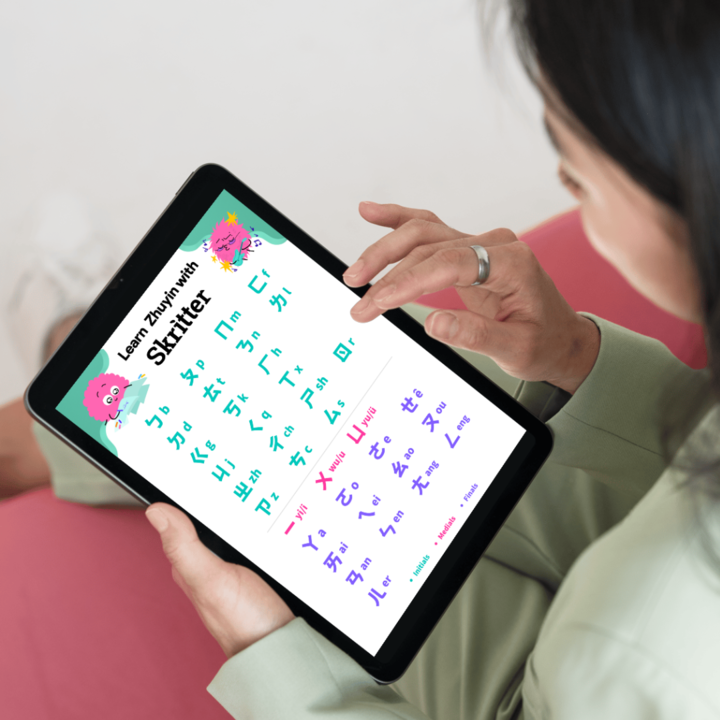 Many people believe that learning a new script is challenging, but mastering systems like Zhuyin (Bopomofo) or Japanese kana is surprisingly easy. With the right approach and resources, you can do it in just a few hours!
Many people believe that learning a new script is challenging, but mastering systems like Zhuyin (Bopomofo) or Japanese kana is surprisingly easy. With the right approach and resources, you can do it in just a few hours!
When learning Chinese, some things are harder than they seem, but fortunately, others turn out to be easier than you might expect. Learning a new transcription system is one of those easier tasks. At least if you go about it the right way.
Tune in to the Hacking Chinese Podcast to listen to the related episode (#221):
Available on Apple Podcasts, Spotify, YouTube and many other platforms!
How I learnt Zhuyin (and Japanese kana)
After my first year of learning Chinese at university in Sweden, I received a scholarship to study in Taiwan, which meant I needed to learn both Zhuyin (Bopomofo) and traditional characters. Both turned out to be easier than I expected, but this article is about learning Zhuyin. I have already written about simplified and traditional characters here.
Becoming comfortable with Zhuyin took me about two hours. I’ve also learned Japanese hiragana and katakana, which have a similar number of symbols to Zhuyin, and each of those took about the same time to learn. If this sounds obvious to you, this article might not be for you. But if you’re curious about how I did it, and how you can apply the same method to learning any phonetic writing system, whether it’s Hangul, Cyrillic, or Arabic, read on!
What is Zhuyin (注音) or Bopomofo (ㄅㄆㄇㄈ)? Is it useful to learn?
Zhuyin is a transcription system for Chinese that has been around for over a century. The formal name is 注音符號 (Zhùyīn fúhào), or Zhuyin for short. In colloquial speech, it’s often referred to as Bopomofo after the first four initials ㄅㄆㄇㄈ. Today, Zhuyin is mostly used in Taiwan, where it is the most prevalent transcription system. It looks like this:
There are several reasons to learn Zhuyin. The most obvious ones are that it’s used in Taiwan, so if you want to communicate with people there, you need to know it. People use it in online text chat and to type on computers and phones, and it can be invaluable to clarify if a word ends in -in or -ing by signing the symbol for those finals.
Learning Zhuyin can also be useful because it provides a different angle on pronunciation. It’s easy to think that Pinyin and Mandarin pronunciation are the same, but they’re not. If you rely too much on written Pinyin without listening and paying attention, the familiar letters and the sound you associate with them in your native language, might block or influence what you hear in Mandarin. Pronouncing Mandarin based on how letters are pronounced in English is even worse, of course. Zhuyin doesn’t have this issue, because you can’t cheat.
For more about different transcription systems along with their pros and cons, check the series of articles starting here: Learning to pronounce Mandarin with Pinyin, Zhuyin and IPA: Part 1:
Learning to pronounce Mandarin with Pinyin, Zhuyin and IPA: Part 1
Learn with Skritter’s free Zhuyin video course
I’ve been meaning to write this article for almost a decade, and now finally found the motivation to finish it, all because Skritter has published a free Zhuyin course. As regular readers will know, I work for Skritter, but I did not contribute much to this course itself (unlike the Skritter’s character course). I think the course makes it a lot easier to learn Zhuyin, however, and now that I can include information from the course here, I feel motivated to help you learn Zhuyin!
I will refer to Skritter’s Zhuyin course throughout this article, but everything I say here works well without fancy tools; you can even do flashcards on paper if you prefer! The course is part of the free content available to guest accounts on Skriter, however, so taking the course doesn’t cost you anything. If you use this link, or any other link in this article, you will both get 10% off if you do end up subscribing to Skrtiter and help support Hacking Chinese!
The videos in the course will be published on YouTube later, but for now, I have embedded them here (Vimeo):
How to learn Zhuyin/Bopomofo in two hours
Here’s an overview of the method I propose. These steps are meant to be followed in sequence, but you don’t have to complete step one for all the symbols before moving on. You could, for example, finish step one for a subset of symbols, then move on to step two, and later return to step one for the next set. If you only want to learn to read the symbols, you can probably skip step three. If you love flashcards, spend less time
- Study, understand, and learn the symbols (30 minutes)
- Commit to memory using spaced repetition (45 minutes)
- Use Zhuyin for reading and typing(45 minutes)
Before I go into detail for each step, it’s important to clarify one thing: what about learning the sounds and tones? If you read last week’s article, you know where this is headed, but to summarise briefly, the sounds and tones of Mandarin are not the same thing as the symbols used to write them down.
If you’re completely new to the sounds and tones of Mandarin, learning them will take much longer than 30 minutes (check out my pronunciation course if that’s what you’re after). What we’re focusing on here is the transcription system itself; the written symbols and how they map to spoken sounds. For more on why spoken sounds and written symbols are two different things, check out What’s the difference between Chinese pronunciation and Pinyin? Does it matter?
Step 1: Study, understand, and learn the Zhuyin symbols
Learning and remembering something meaningful is always easier than studying something that appears random. I’ve discussed this in more detail when it comes to learning Chinese characters, but it’s equally true for Zhuyin symbols: if you regard them as jumbles of strokes, learning them will be harder than if you can connect them to something meaningful.
This is best done by first learning the overall structure of what you want to learn. Once this structure is in place, learning additional details is not as hard. For Zhuyin, this is not hard. You need to know that:
- There are symbols for initials, medials and finals
- These are combined vertically to form syllables
- Tones are written as in Pinyin, except the first tone, which is default and left blank
You can also watch the relevant video:
Next, it’s time to look at the 37 individual symbols. As before, it’s essential to associate them with something meaningful and avoid regarding them as a random jumble of strokes.
 There are two ways to do this. First, you can learn about the origin of each symbol. Let’s have a look at three examples:
There are two ways to do this. First, you can learn about the origin of each symbol. Let’s have a look at three examples:
- ㄅ, Pinyin “b”, comes from 包 (bāo)
- ㄉ, Pinyin “d”, comes from 刀 (dāo)
- ㄒ, Pinyin “x”, comes from 下 (xià)
Not all symbols come from beginner-friendly characters like these, but many do. Connecting these new symbols to something you already know is very powerful, so do that whenever you can. A full list of symbol origins can be found on Wikipedia here.
Second, if this is not helpful, maybe because you don’t know the character or because the origin is too convoluted, you can make something up. See if you can find a character or word in Mandarin that connects with the symbol. For example:
- ㄐ, Pinyin “j”, comes from 丩 (jiū), which you probably don’t know. It is the sound component in 叫 (jiào, however, so you could associate it with that.
- ㄜ, Pinyin “e”, comes from a character that is no longer used. Maybe think of it as an “e” with the middle bar pointing up?
- ㄘ, Pinyin “c”, comes from 七 (qī), which is deeply unhelpful because that’s not the sound it represents in Modern Mandarin. How about associating it with 草 (cǎo, “grass”), regarding the horizontal stroke as the ground, the bit sticking up as grass and the bit below as roots?
Note that mnemonics are not strictly necessary here and that you can learn a limited set of symbols like this simply through pure repetition. You might forget symbols occasionally, but if you keep using them, you will learn them. Mnemonics are great if you want to invest a minimum of time or retain knowledge over time without repeating it often. In other words, mnemonics work best when the speed of recall is not your primary concern.
This video in Skritter’s Zhuyin course goes through all the symbols, with examples:
Step 2: Commit the Zhuyin symbols to memory using spaced repetition
Once you’ve studied the symbols, it’s time to commit them to long-term memory through spaced repetition and active recall. These techniques, which tools like Skritter are designed for, allow you to memorise symbols like these with less than a minute of active study time per symbol. Some symbols will be easy and you will learn them right away, others you might get wrong a few times before they stick, but 45 minutes over a week or so should do the trick!
If you study the course in Skritter, you’ll automatically learn and review all the Zhuyin symbols. The deck has several sections containing all the 37 symbols, along with the videos embedded throughout this article. If you use another flashcard program, you can probably find decks with the Zhuyin symbols or create one yourself. Naturally, good old paper flashcards also work well, especially for a limited project like this!
Flashcards excel at memorising things like this, but flashcards also have downsides. If you don’t like flashcards, you can skip step two here and go directly to step three. I still recommend using flashcards when initially committing the Zhuyin symbols to memory, however, as it is extremely efficient and doesn’t take much time. You don’t have to keep using flashcards after the initial learning phase!
Step 3: Use Zhuyin for reading and typing
Now that you’ve committed the symbols to memory, it’s time to practise. If you skipped step two, you’ll need to spend more time here in step three. For maximum efficiency, don’t forget to spread your practice out over time!
 One of the best ways to not just know Zhuyin but become comfortable with it is to change your input method to Zhuyin on your phone. Anything you type in Chinese in the coming week will have to be through Zhuyin. Naturally, you don’t need to change permanently, just while you’re getting the hang of Zhuyin! You can also do this on your computer, but this is less effective if you don’t have a physical keyboard with the Zhzuyin symbols on it.
One of the best ways to not just know Zhuyin but become comfortable with it is to change your input method to Zhuyin on your phone. Anything you type in Chinese in the coming week will have to be through Zhuyin. Naturally, you don’t need to change permanently, just while you’re getting the hang of Zhuyin! You can also do this on your computer, but this is less effective if you don’t have a physical keyboard with the Zhzuyin symbols on it.
When typing on your phone, you can see the symbols all the time, and you know if you got the right ones if the right characters appear on the screen. If you did steps one and two properly, you should be able to recall most of the symbols but don’t hesitate to sneak peek if you need to.
The fourth video in Skritter’s Zhuyin course covers typing on phones and computers:
Gaining a certain amount of fluency with Zhuyin doesn’t require a lot of typing. 45 minutes of effective typing is a lot and will make sure you know Zhuyin quite well. Naturally, to maintain this ability over time and gain increased fluency, you might want to keep using Zhuyin for longer, but that’s up to you!
Zhuyin: Beyond transcription
As mentioned, learning Zhuyin can provide a new angle on pronunciation, but it’s worth noting that it’s more than a transcription system. Similar to the way Piynin is sometimes used instead of Chinese characters (for example writing TA as a gender-neutral third-person pronoun), people in Taiwan also use Zhuyin symbols when writing, especially online. For example, you might see people write ㄇ instead of 嗎 or ㄉ instead of 的.
The last video in Skritter’s course covers this aspect of Zhuyin:
You can learn Zhuyin in two hours
To wrap up, learning Zhuyin in two hours is entirely achievable because it’s not about mastering a language or a complicated script but simply learning a set of 37 symbols and some simple rules for how to combine them.
By understanding the symbols, using spaced repetition, and communicative typing, you can learn Zhuyin in just a few hours. Try it and let me know how it goes!


